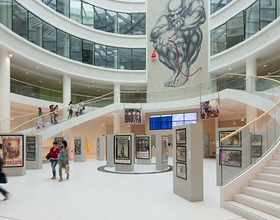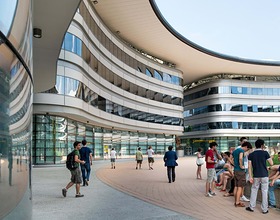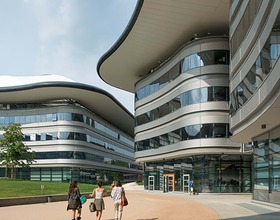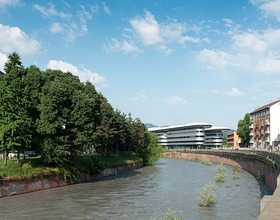TURIN UNIVERSITY - CAMPUS LUIGI EINAUDI
-
Uniting the faculties of Law and Political Science within a single, modern campus for 5,000 students, the project has created flexible new facilities for Turin University, as well as establishing new connections between the institution and wider community.
The design links the former Italgas site on the southern bank of the River Dora with the neighbourhood of Borgo Rossini, regenerating a formerly industrial quarter close to the historic heart of the city, and turning the former source of Turin’s energy into an educational powerhouse to drive future prosperity.
The design is a modern interpretation of the traditional cloistered quadrangle, formed of two linked buildings, unified by a single roof canopy and arranged around a central courtyard. A new four-storey library is located on the northern edge of the site, parallel to the River Dora, with the Law and Political Science faculties to the south – each faculty has its own entrance from the central courtyard.
The ground floor accommodates lecture halls, circulation and social spaces, with teaching and faculty rooms in the quieter levels above. The first floor mezzanine is visible in the double-height atrium at the entrance to each faculty, animating the linear route that runs the entire length of the building. A roof garden provides a quiet space for study. Floor plates are flexible to support changes in teaching priorities, and an innovative design for the 500-seat auditorium allows it to be split in two, with 250 seats in each side.
Sensitively combining existing and efficient new structures, some of the site’s historic buildings have been refurbished to house a café and student services – the former Piccolo Italgas building signals the main entrance to the campus, reached via the revitalised Via Vegezzi gardens.
The masterplan creates a traffic-free oasis in the heart of a city plagued by congestion – vehicle access is from Corso Farini, where a covered gateway provides a sheltered, accessible route to the library and faculty buildings.
The green setting includes a meandering ‘philosopher’s walk’, as well as new riverside paths and pedestrian routes that promote movement and life through the site and link with local rail and bus services. In addition, more than 7,200 square metres of photocatalytic paving tiles have been used in the hard landscaping to help neutralise the polluting effects of dust.
The buildings incorporate a number of energy saving features, including passive strategies such as the overhanging roof, whose depth is determined by solar path analysis. The combination of natural and artificial lighting reduces energy use by almost 20 percent, intelligent building control systems ensure operational efficiency and a Tri-generation source provides heating and cooling, while requiring 20 percent less energy than individual plant facilities.
Photo credits: Foster + Partners.
1870 Projects












